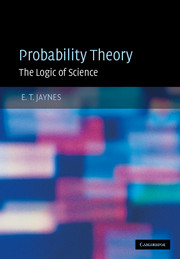Book contents
- Frontmatter
- Contents
- Editor's foreword
- Preface
- Part I Principles and elementary applications
- 1 Plausible reasoning
- 2 The quantitative rules
- 3 Elementary sampling theory
- 4 Elementary hypothesis testing
- 5 Queer uses for probability theory
- 6 Elementary parameter estimation
- 7 The central, Gaussian or normal distribution
- 8 Sufficiency, ancillarity, and all that
- 9 Repetitive experiments: probability and frequency
- 10 Physics of ‘random experiments’
- Part II Advanced applications
- Appendix A Other approaches to probability theory
- Appendix B Mathematical formalities and style
- Appendix C Convolutions and cumulants
- References
- Bibliography
- Author index
- Subject index
5 - Queer uses for probability theory
from Part I - Principles and elementary applications
Published online by Cambridge University Press: 05 September 2012
- Frontmatter
- Contents
- Editor's foreword
- Preface
- Part I Principles and elementary applications
- 1 Plausible reasoning
- 2 The quantitative rules
- 3 Elementary sampling theory
- 4 Elementary hypothesis testing
- 5 Queer uses for probability theory
- 6 Elementary parameter estimation
- 7 The central, Gaussian or normal distribution
- 8 Sufficiency, ancillarity, and all that
- 9 Repetitive experiments: probability and frequency
- 10 Physics of ‘random experiments’
- Part II Advanced applications
- Appendix A Other approaches to probability theory
- Appendix B Mathematical formalities and style
- Appendix C Convolutions and cumulants
- References
- Bibliography
- Author index
- Subject index
Summary
I cannot conceal the fact here that in the specific application of these rules, I foresee many things happening which can cause one to be badly mistaken if he does not proceed cautiously.
James Bernoulli (1713, Part 4, Chapter III)I. J. Good (1950) has shown how we can use probability theory backwards to measure our own strengths of belief about propositions. For example, how strongly do you believe in extrasensory perception?
Extrasensory perception
What probability would you assign to the hypothesis that Mr Smith has perfect extrasensory perception? More specifically, that he can guess right every time which number you have written down. To say zero is too dogmatic. According to our theory, this means that we are never going to allow the robot's mind to be changed by any amount of evidence, and we don't really want that. But where is our strength of belief in a proposition like this?
Our brains work pretty much the way this robot works, but we have an intuitive feeling for plausibility only when it's not too far from 0 db. We get fairly definite feelings that something is more than likely to be so or less than likely to be so. So the trick is to imagine an experiment. How much evidence would it take to bring your state of belief up to the place where you felt very perplexed and unsure about it?
- Type
- Chapter
- Information
- Probability TheoryThe Logic of Science, pp. 119 - 148Publisher: Cambridge University PressPrint publication year: 2003
- 1
- Cited by



